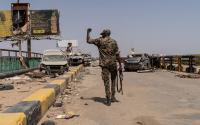23 April 2006Girish Mishra
Ever since Indian Prime Minister Dr Manmohan Singh has announced his resolve to make the rupee fully convertible on capital account, it has given rise to a fierce controversy. While the corporate sector, and the media and some economists, loyal to Washington consensus-based globalisation, are for it a large number of other economists and journals term it as disastrous for the country. Before we have a look at their respective positions, let us go a bit in its history.
Way back in 1991 when Dr Manmohan Singh, as finance minister in the P. V. Narasimha Rao government initiated economic reforms, contingent upon the acceptance of Washington consensus, financial liberalisation constituted one of the key elements. To begin with, he made the rupee convertible on current account and postponed its convertibility on capital account to a later date. In other words, the rupee became convertible for trade, but restrictions remained on the outflow and the inflow of capital. Neither residents were allowed to purchase foreign assets nor were non-residents allowed to invest in assets in India without the clearance from appropriate authorities.
Over the years, the restrictions on capital account convertibility have been relaxed, yet they have not been fully done away with. In 1997, when P. Chidambaram, the present finance minister, was in the same position, he termed it as "a cherished goal". The Reserve Bank of India RBI) then set up a committee headed by S. S. Tarapore, which recommended ending controls on capital account convertibility so that by 2000 the rupee could become fully convertible. The recommendation was made in June 1997, but, as ill luck would have it, the Asian crisis broke out on July 1. Consequently, the report was shelved. It needs to be noted that India escaped unscathed because it had not made the rupee convertible on capital account. Malaysia too could overcome the crisis because it clamped restrictions on the outflow of capital despite pressures and denunciations by the IMF and powerful sections in American government and corporate sector.
The Tarapore committee had suggested the fulfillment of certain conditions before embarking on full convertibility of the rupee on capital account. These included restricting inflation, containing fiscal deficit and strengthening financial system besides keeping a watch on balance of payments and the quantum of foreign exchange reserves.
The protagonists think that now is the ideal time for making the rupee fully convertible on capital account. Dr Manmohan Singh holds that Indian economy is, both internally and externally, in much stronger position conducive to it. To quote, "Given the changes that have taken place over the past two decades, there is merit in moving towards fuller capital account convertibility within a transparent framework." It is claimed that, with full convertibility of the rupee, India will get completely integrated with the global economy. The inflow of FDI (foreign direct investment) will accelerate and the rate of growth of economy will go up. In addition, Indians will invest more freely abroad and earn and bring profits back. Indian companies will have greater access to foreign borrowings, which are at present limited to $500 million per company per year. To quote Anil Ambani, "It will be a huge step forward for Indian business…. For India, in terms of its impact on the mind-set of businessmen, it will be like taking a step on the moon and will also send a clear message to ratings agencies that our economic reforms are moving forward and tough decisions will be taken." It is hoped that the rating agencies like Fitch Ratings and Standard and Poor that put India below investment grade will be prompted to revise their judgment to encourage the inflow of FDI. Montek Singh Ahluwalia, vice-chairman of the Planning Commission is confident of putting proper mechanism of for convertibility in the 12th Plan that commences two years hence. Bimal Jalan, a former governor of the RBI and otherwise critical of Manmohan Singh's policies, too, has put on record: "The PM is absolutely right in underlining the fact that India can move forward at a faster pace than earlier because of global interest in investing in India and our stronger external situation."
Even though the recommendations and the time-table produced by the Tarapore committee in its 80-page report in 1997 was consigned to the dustbin after the outbreak of the financial crisis in south-east Asia, the task of making rupee fully convertible was pursued, albeit, gradually. The Foreign Exchange Management Act (FEMA) of 1999 replaced the Foreign Exchange Regulation Act (FERA) of 1973 that provided for controlling all foreign exchange transactions regardless of the quantum. The latter changed the spotlight of the law from "controlling" and "permitting" to "facilitating"; and stringent provisions of the FERA were substantially diluted. Most of the current account transactions could be carried on without interference by the RBI. Except the payments towards technical know-how, no business or trade payments on current account could be regulated by the RBI. The quantum of foreign exchange for foreign travel was raised to $25,000 per year. Besides, an Indian citizen could remit or take out a sum of $25,000 a year without the permission of the RBI. Even the capital account transactions, to some extent, came to be liberalized in spite of FEMA regulations. The inflow of FDI in a number of cases was put on automatic route while the portfolio investments by FIIs (Foreign Institutional Investors) were already convertible. At present external commercial borrowing by a company to the extent of $500 million does not require the approval of either the RBI or the finance ministry. The full convertibility of the rupee on capital account will dispense with whatever controls and regulations remain. It will make all resident companies, individuals and other entities eligible to invest, disinvest or transact in any property or assets/liability of any country, convert one currency into another or move funds anywhere in the world without any legal restrictions. The Tarapore committee of 1997 defined the capital account convertibility as "the freedom to convert local financial assets into foreign financial assets and vice versa at market determined rates of exchange." In other words, it implies complete mobility of capital across countries. It is argued that the benefits from it will be efficient allocation of global capital because of the equalisation of the rates of return of capital across the countries besides the increased level of output and equitable distribution of income. Keeping in mind the pronouncements by and the mood of the top people in the government as well as the composition of the second Tarapore committee, there is no doubt about making the rupee fully convertible as early as possible. Surjit Bhalla (who rarely deviates from Fund-Bank line and is a member of the second Tarapore committee and also sat on the first) has asserted: "We need it for the Indians, not the foreigners."
There is, however, a stiff opposition to the move from the left parties, leading economists and some prestigious journals. They think, it may lead to disastrous consequences. One hundred fifty leading economists have come out with a logically argued case against the full convertibility of the rupee on capital account. They say, it is not a precondition for accelerating the inflow of FDI. Three countries of Asia, namely, China, Taiwan and South Korea, could attract FDI without making their currencies fully convertible on capital account. They warn that full capital account convertibility may expose India to extreme volatility if residents take out capital from the country on a significant scale. One must draw proper lessons from the recent economic history of Latin America where the outflows of capital pushed a number of countries into debt trap. The Economic and Political Weekly, a prestigious journal, in an editorial has asked whether it will not lead towards "casino capitalism". Expressing a similar apprehension, Srinivasan Vardarajan, managing director of J. P. Morgan (India) says, "We have only seen the inflow of foreign money so far, but we have not seen investments taken out of the country in a hurry."
Prof. Dani Rodrik of the Harvard University, in a paper "Who Needs Capital Account Convertibility?", has made certain significant observations that need to be pondered over before going ahead. First, "IMF's… mission the liberalization of capital accounts …sounds generally odd. One wonders which of the ills of international capital markets the proposed medicine will remedy. Will the African countries get the foreign capital they need if they remove capital controls? Will "emerging markets" be less at risk of being flooded with foreign capital when such flows conflict with the domestic goals of inflation control or of maintaining a competitive exchange rate? Will sudden reversals become less likely than before? Will contagion across countries become less severe? Will more of the inflows take the form of long-term physical investments rather than short-term flows?"
Second, "It is not that capital controls are necessarily the answers to these problems; they are not. But capital-account liberalization fits the bill even less."
Last, "There is no evidence … that countries without capital controls have grown faster, invested more, or experienced lower inflation. Capital controls are essentially uncorrelated with long-time economic performance once other determinants are controlled for."
Wisdom demands that the government invites a nationwide public debate when the second Tarapore committee submits its report on July 31.
Girish Mishra E-mail: [email protected]
http://www.zmag.org/content/showarticle.cfm?SectionID=32&ItemID=10143






